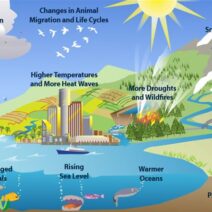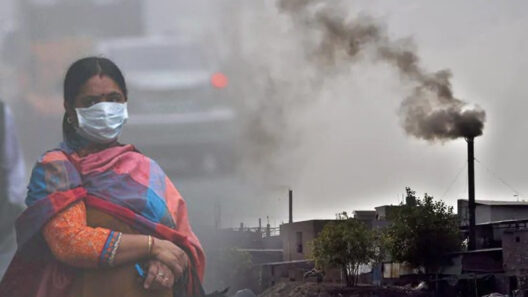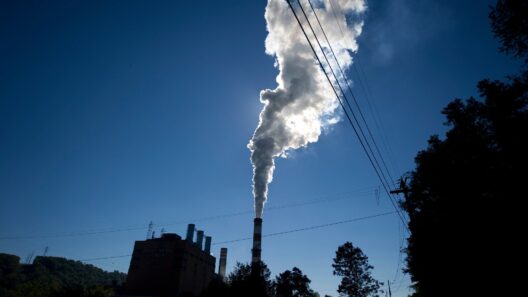The discourse surrounding climate change has intensified in recent decades, invoking fear and a sense of urgency among global populations. A central figure in this dialogue is carbon dioxide (CO₂), a greenhouse gas that plays an integral role in the Earth’s climate system. Within climate science, one intriguing phenomenon is known as the CO₂ band saturation effect, a concept often discussed with a mix of skepticism and conviction. This effect posits that as CO₂ levels increase, their capacity to absorb heat becomes saturated, leading some to claim that additional emissions will have little to no impact on global warming. However, the reality is far more intricate, woven into the fabric of atmospheric dynamics and thermodynamics.
To begin, it is critical to grasp the fundamentals of the greenhouse effect—a natural process that warms the Earth’s surface. Solar radiation strikes the Earth, and while a portion is reflected back into space, the remainder is absorbed and subsequently reradiated in the form of infrared radiation. Greenhouse gases like CO₂ trap some of this outgoing radiation, creating a warming effect. The band saturation effect posits that at certain wavelengths—specifically in the infrared spectrum—CO₂ absorption bands become saturated, suggesting a diminishing return on the warming potential as CO₂ concentrations increase.
As CO₂ levels in the atmosphere rise due to human activities such as fossil fuel combustion and deforestation, a critical question emerges: Does this saturation impact the efficacy of CO₂ as a greenhouse gas? The answer lies in the nuanced understanding of atmospheric physics. Initially, increasing CO₂ concentrations do indeed saturate specific wavelengths of infrared radiation; however, the Earth’s atmosphere is not static. Changes occur with the stratification of atmospheric layers and the interplay of various greenhouse gases.
While it is true that the most significant absorption bands for CO₂ are becoming saturated, the atmosphere is not a simple two-dimensional interface. As CO₂ concentrations rise, the atmosphere’s temperature increases, enhancing the capacity for water vapor, another significant greenhouse gas, to absorb heat. This interaction can effectively amplify the warming initiated by additional CO₂ emissions. Thus, the saturation effect does not nullify the greenhouse potency of CO₂; rather, it increases the complexity of understanding how multiple gases influence climate dynamics.
A common misconception arises when critics suggest that because saturation occurs within specific wavelengths, an infinite emission of CO₂ will yield negligible warming effects. This perspective neglects to consider the cumulative nature of greenhouse gases. Even if certain wavelengths become saturated, the overall energy balance of the Earth can be significantly altered by increasing concentrations of CO₂. The significant uptick in global temperatures observed over the past century correlates closely with rises in atmospheric CO₂, affirming that the band saturation effect does not diminish the gas’s warming potential.
Moreover, the environmental ramifications of ignoring the saturation effect can be catastrophic. Climate models indicate that even small increases in global temperatures can trigger feedback loops, such as the melting of polar ice caps and permafrost, which then release further greenhouse gases into the atmosphere. This chain reaction reinforces the argument against dismissing the potential of additional CO₂ emissions as benign or inconsequential due to the band saturation effect.
The intricacies of climate dynamics extend beyond CO₂ alone. Other greenhouse gases, such as methane (CH₄) and nitrous oxide (N₂O), come into play, further complicating the narrative. Each gas exhibits different absorption characteristics and atmospheric lifetimes, meaning the implications of their concentrations differ markedly. For instance, while methane has a far stronger warming potential than CO₂, it is less prevalent in the atmosphere. Addressing global warming necessitates a multifaceted approach that considers all greenhouse gases in concert rather than isolating CO₂’s effects based solely on the saturation argument.
It’s also essential to factor in the new findings regarding cloud formation and climate feedback. Increased CO₂ not only warms the atmosphere but can alter cloud dynamics and precipitation patterns. As the climate warms, the interactions between clouds and radiation become increasingly complex. Some clouds may reflect solar energy, potentially mitigating some warming, while others may enhance greenhouse gas trapping. The net effect remains uncertain, but the overarching trend points toward heightened warming potential rather than a stable climate.
In light of this extensive interplay, it becomes clear that the notion of the CO₂ band saturation effect preventing or significantly mitigating global warming is overly simplistic. To hope for a trivialized impact from additional CO₂ emissions is to overlook the underlying physics of the Earth’s atmosphere and the impurities that characterize it. An understanding of climate change requires a multidisciplinary perspective, bridging gaps between physics, chemistry, and environmental science.
As advocates for action against climate change, it is imperative to articulate these complexities to foster informed dialogue. Public understanding of the saturation effect must be nuanced—emphasizing that, while certain wavelengths may experience saturation, the overall impacts of rising CO₂ levels in our atmosphere are profound and alarming. Political, social, and economic spheres must align to address the multifaceted challenges posed by climate change.
In conclusion, the CO₂ band saturation effect cannot be viewed as a safeguard against global warming. Rather, it demands a paradigm shift in perspective—a call to curiosity and deeper inquiry into how every facet of the greenhouse gas phenomena intertwines with the Earth’s climatic future. Even in the face of saturation, the urgent need for global action and sustainable practices remains more crucial than ever, lest we be caught in a climate quagmire of our own making.








